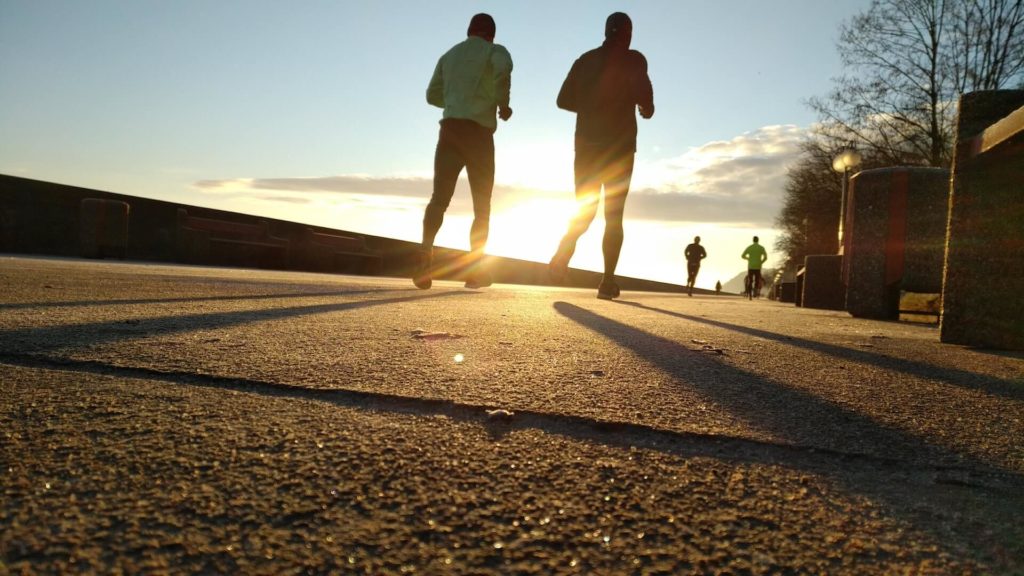Walking every day has health benefits
1. Increases your heart health
Running is more efficient than walking. Running requires more intensity than walking, so you will need to walk longer than you run to reap the cardiovascular benefits. Consider the extra time it takes to get warm and cool down, change of clothes, and for showering. If you run, you should factor in time.
You can easily add a few extra minutes to your day by walking, even if you don’t have to shower. You wouldn’t walk in heels or a suit and tie from your desk to the kitchen to get lunch. But you can add walking time to your day.
Taking your dog for a quick walk
Lunchtime: Walking around the office building
When you are running errands, park far from the stores and take the stairs.
With a friend, walk around the mall
It is better to get up and ask a colleague a question face-to-face than to email them.
To be able to keep the motivation to walk more, you must first understand how walking can improve your heart health. These are some concrete ways to do that.
It can lower blood pressure which can increase the risk of developing heart disease.
Walking helps you lose weight and reduce stress.
Your heart muscle is strengthened, allowing it to pump blood more efficiently to other parts of your body.
Reduces stress hormones that can be a burden on your heart
You can get great exercise by walking with your favorite music on and your senses of purpose.
2. It will boost your mood
What can you do after a difficult day or during it?
Can you imagine a candy bar? A glass of wine? A bowl of ice-cream?
Calories are what make me happy. Walking is a stress-reducing and calorie-reducing method. It also improves your mood.
Research has shown that taking walks outdoors on a regular basis can improve your nervous system and decrease your anger. This is especially beneficial in winter when the days are shorter and seasonal depression is high.
Another study examined the link between walking in nature and developing a mental illness. Participants who walked for at least 90 minutes in nature showed a lower activity level in the brain area that is linked to cognitive diseases. They also had lower levels of rumination (repetitive, negative thoughts) than those who walked in urban environments.
Invite a friend along with you on your walk. This exercise can be social. It allows you to connect with people you care about and helps you feel better.
What if it isn’t a beautiful day? Can you watch television instead? No. A 2016 study found that walking is still a strong mood booster, even when you remove any happiness factors such as sunshine, socializing and listening to music. This may be because it’s hardwired into our DNA. Researchers found that moving is linked to positive activities such as going on a hunt for food and land. Walking still is a positive activity that encourages achievement.
Three experiments were conducted by the researchers to determine if walking can produce positive emotions. One group of college students walked through campus buildings while the other watched a video. The second experiment was a comparison between two groups. The experiment showed that campus strollers felt more confident, active, and alert than the control subjects. However, their attentiveness and mood levels dropped.
The second experiment involved students being asked to go on a walking tour, then write an essay. This was done in order to put pressure on them. The students managed to maintain a positive attitude despite the stress of writing an essay.
Students were required to walk on a treadmill for the final experiment. The students experienced an increase in mood compared to students who sat or stood.
Walking can make you feel happier, no matter how bad the weather is. Doctors agree that walking is a natural treatment for depression. Brain chemistry is a major factor in depression. Walking can help your brain release endorphins which will allow you to achieve the same results that many drugs are trying to artificially.
3. Walking will give you good ideas
You may feel like you are at a mental block, whether it’s for a few minutes or a whole day. This problem can be alleviated by going for a walk, which allows your mind and body to wander. Research has shown that intense, vigilant deliberation (i.e. When you are trying to make complex decisions or come up with new ideas, sitting at your desk and thinking can be very debilitating.
You can go on a walk to allow your mind to wander. This is often when people have those “lightbulb moments” when a decision or idea becomes crystal clear.
A Stanford study found that walking can increase creativity by up to 60%. This type of thinking process is called “divergent thought,” and it’s effective at generating creative ideas. Your mind can explore many possible solutions if it just lets go. This study shows that walking encourages innovative thinking. It is a good way to get in some exercise and boost creativity.
Walking can boost brain power as it sends pressure waves up through your blood vessels, increasing blood flow to your brain. A healthy level of blood is essential for brain function. It keeps your brain hydrated and gives it the nutrients it needs.
4. It can help keep varicose veins at bay
Walking can improve blood circulation and reduce varicose veins. Varicose veins can be a sign of aging. While they aren’t common in all aging adults (about half), they are a visible reminder of the passing of time. You don’t have to be scared, I will explain how varicose vessels develop.
why walking is good for your health
Walking every day helps strengthen your circulatory system, muscles in the bottom of your body and promotes healthy blood flow.
Your lower body’s vein system returns blood from circulation to your heart and lung. Your deep veins help move your blood upwards. However, there is a system that works against gravity to stop your blood from returning to your legs. These valves can fail, which puts more pressure on your vein walls. This makes it difficult for your muscles push your blood up again. Instead of your blood moving between the valves, your blood pools in your veins. This increases pressure, causes your veins twist, swell and protrude, and further reduces your ability to move between them. You now have varicose blood vessels.
Walking every day is a great way to avoid this. It strengthens your circulatory system, muscles in the bottom of your body, and encourages healthy blood flow. Walking on a daily basis is a good way to reduce swelling and relieve restlessness if you have varicose or spider veins. Walking can also help to delay the onset of spider veins or varicose veins in your family.
5. This reduces your risk of developing breast cancer
The American Cancer Society found that walking for at least an hour per day can lower your risk of developing breast carcinoma. However, a study that was focused on walking showed that women who walked more than three hours per week had a 14% decrease in their chances of getting it.
It is still not clear how exercise reduces breast cancer risk. Walking, for example, helps women to maintain a healthy weight and regulates hormones like estrogen and insulin. These hormones can promote the growth of breast cancerous cells. Keeping these hormones in check also helps to maintain a healthy immune system. Women who are overweight or take supplemental hormones may be able to walk for protection.
Another unknown aspect is how far women must walk to prevent cancer. We do know that walking is better then none and that more walking is better.
6. Improve Bone Density
Healthy bone density is important, more than you might think. Strong bones are better than weak bones and can help avoid osteoporosis.
The American Bone Health Association states that weight-bearing activities such as walking are the best way to keep your bones strong. Researchers found that people who walk regularly for at least six months have a higher hip bone density than those who do not. When your friends get hip replacements, you will be able to thank yourself later.
7. It is a natural painkiller
If you have chronic pain, it is possible to be reluctant to get out on a long-distance walk. Here’s a story about a woman in her 40s that believed just the opposite. A study published in Annals of Rehabilitative medicine found that walking on a regular basis can help reduce chronic pain. This woman is living proof of this.
Finding the right exercise is key to reducing pain. Walking can help you manage your pain.
Many people who experience chronic pain are suffering from arthritis. Walking programs are available for people with osteoarthritis. This is because of their effectiveness. Walking and similar movements are essential for maintaining healthy cartilage.
University of Rochester Medicine has published numerous studies that show walking is as effective as doing abdominal and back strength training routines for chronic lower back pain sufferers. Walking outside with the goal of relieving chronic lower back pain is better than using a treadmill. Studies have shown that this activity engages more muscles and allows you to adapt to different terrains.
Walking activates the endogenous opioid systems, so walking is an easy way to reduce pain and release opioids. This is what you’ve probably heard about the runner’s high.
8. Improves Digestion
One in five people have some type of digestive problem. This surprised me. Given the frequency with which people complain about constipation, bloating, acid reflux, etc., I expected the number to be higher.
Even if you don’t have a chronic digestive problem, walking every day can help improve your digestion. Walking, or any other form of exercise, can increase your food transit time by as much as 30%. This can help you reduce constipation symptoms and IBD symptoms.
Walking regularly can help strengthen your digestive system and keep you healthy. Your digestive muscles will work better when you are in good shape to avoid any discomfort.
9. Reduce joint pain
Although you might think that walking increases joint pain due to the extra weight that it places on your body, the truth is that it does the exact opposite. Because of this, when you move, blood flow to your muscles can increase, which can help increase strength around your joints.
A recent study has shown that regular walking can delay the development of arthritis pain in older people. Study participants included 1,564 people with chronic lower-body pain. Participants who couldn’t walk for more than an hour per week reported difficulty completing their morning routines. However, participants who could stick to the walking schedule experienced increased mobility and were able complete everyday tasks with greater ease.
Walking can reduce or even eliminate arthritis-related joint pain. Walking protects your joints and strengthens the muscles surrounding them. It also helps to lubricate your joints so they can move freely. This is particularly true for the hips and knees, which are more susceptible to osteoarthritis. You can improve your mobility and range, which will reduce the risk of sustaining a motion-related injury.
10. It will help you in your weight loss efforts
Walking can be a great way to lose weight.
Let’s first look at the link between genetics and body weight. Harvard researchers examined the effects 32 obesity-promoting genes on over 12,000 individuals. The impact of these 32 genes on body weight was reduced by half when people took power walks for an hour every day. It is possible to reduce the risk of obesity in those with a genetic predisposition by walking.
Walking every day can help you lose weight, provided you are aware of how many steps each day you need to achieve a calorie deficit. You also have to commit to doing it. This low-impact exercise can help you to burn fat, increase insulin sensitivity, and improve your body’s overall composition.











